Crevasse
A crevasse is a deep crack, or fracture, found in an ice sheet or glacier, as opposed to a crevice that forms in rock. Crevasses form as a result of the movement and resulting stress associated with the shear stress generated when two semi-rigid pieces above a plastic substrate have different rates of movement. The resulting intensity of the shear stress causes a breakage along the faces.
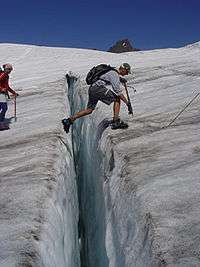
Description
Crevasses often have vertical or near-vertical walls, which can then melt and create seracs, arches, and other ice formations.[1] These walls sometimes expose layers that represent the glacier's stratigraphy. Crevasse size often depends upon the amount of liquid water present in the glacier. A crevasse may be as deep as 45 metres and as wide as 20 metres.[2]
A crevasse may be covered, but not necessarily filled, by a snow bridge made of the previous years' accumulation and snow drifts. The result is that crevasses are rendered invisible, and thus potentially lethal to anyone attempting to navigate their way across a glacier. Occasionally a snow bridge over an old crevasse may begin to sag, providing some landscape relief, but this cannot be relied upon. Groups planning to travel on a glacier with the hidden crevasses must be trained to move as a rope team and have proper equipment.
The presence of water in a crevasse can significantly increase its penetration. Water-filled crevasses may reach the bottom of glaciers or ice sheets and provide a direct hydrologic connection between the surface, where significant summer melting occurs, and the bed of the glacier, where additional water may moisten and lubricate the bed and accelerate ice flow.
Types of crevasses
- Longitudinal crevasses form parallel to flow where the glacier width is expanding. They develop in areas of tensile stress, such as where a valley widens or bends. They are typically concave down and form an angle greater than 45° with the margin.[3]
- Splashing crevasses appear along the edges of a glacier and result from shear stress from the margin of the glacier and longitudinal compressing stress from lateral extension. They extend from the glacier's margin and are concave up with respect to glacier flow, making an angle less than 45° with the margin.
- Transverse crevasses are the most common crevasse type. They form in a zone of longitudinal extension where the principal stresses are parallel to the direction of glacier flow, creating extensional tensile stress. These crevasses stretch across the glacier transverse to the flow direction, or cross-glacier. They generally form where a valley becomes steeper.[3]
Gallery

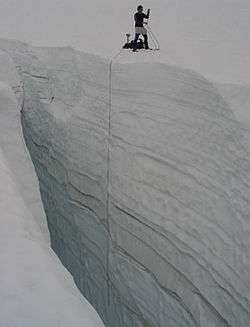
 Exploring the bottom of a crevasse in Antarctica
Exploring the bottom of a crevasse in Antarctica Crevasse on the Ross Ice Shelf, January 2001
Crevasse on the Ross Ice Shelf, January 2001 Crevasses on the Upper Price Glacier of Mt. Shuksan, North Cascades, WA. Photo taken August 2011
Crevasses on the Upper Price Glacier of Mt. Shuksan, North Cascades, WA. Photo taken August 2011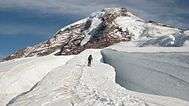 Split-boarder skiing up past open crevasses on the Coleman Glacier of Mt. Baker. Photo taken October 2009
Split-boarder skiing up past open crevasses on the Coleman Glacier of Mt. Baker. Photo taken October 2009 Looking down into a crevasse on Mt. Rainier, Cascade range, WA. Photo taken Mid August 2009
Looking down into a crevasse on Mt. Rainier, Cascade range, WA. Photo taken Mid August 2009 Crevasses on Mt. Rainier. Photo taken from the Disappointment Cleaver Route on Mt. Rainier. Photo taken August 2009
Crevasses on Mt. Rainier. Photo taken from the Disappointment Cleaver Route on Mt. Rainier. Photo taken August 2009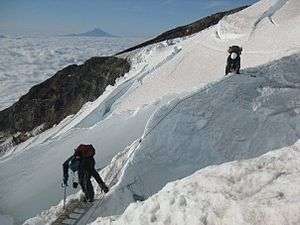 Mountaineers crossing a crevasse on Mt. Rainier. Photo taken August 2009
Mountaineers crossing a crevasse on Mt. Rainier. Photo taken August 2009 Ladder bridging a crevasse on Mt. Rainier. Photo taken Aug. 2009
Ladder bridging a crevasse on Mt. Rainier. Photo taken Aug. 2009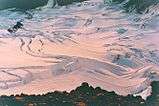 Transverse and splashing crevasses on Emmons Glacier, Mount Rainier, 1995
Transverse and splashing crevasses on Emmons Glacier, Mount Rainier, 1995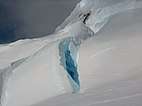 Partly open crevasse in Tangra Mountains, Antarctica, December 2004
Partly open crevasse in Tangra Mountains, Antarctica, December 2004
See also
- Bergschrund – A crevasse between moving glacier ice and the stagnant ice or firn above
- Bowie Crevasse Field – Landform
- Glaciology – Scientific study of ice and natural phenomena involving ice
References
- van der Veen, C (1990). "Crevasses on Glaciers". Polar Geography. 23 (3): 213–245. doi:10.1080/10889379909377677.
- Crevasse by National Geographic
- Holdsworth, G (October 1956). "Primary Transverse Crevasses". Journal of Glaciology. 8 (52): 107–129.
Bibliography
- Boon, S. & M.J. Sharp (2003). "The role of hydrologically-driven ice fracture in drainage system evolution on an Arctic glacier". Geophysical Research Letters. 30: 1916. doi:10.1029/2003gl018034.CS1 maint: uses authors parameter (link)
- Colgan, W. & Rajaram, H. & Abdalati, W. & McCutchan, C. & Mottram, R. & Moussavi, M.S. & Grigsby, S. (2016). "Glacier crevasses: Observations, models, and mass balance implications". Rev. Geophys. 54: 119–161. doi:10.1002/2015RG000504.CS1 maint: uses authors parameter (link)
- "Crevasse". Encyclopædia Britannica (Online ed.).
- Das, S.B., Joughin, I. & Behn, M.D. & Howat, I.M. & King, M.A. & Lizarralde, D. & Bhatia, M.P. (2008). "Fracture propagation to the base of the Greenland Ice Sheet during supraglacial lake drainage". Science. 320: 778. doi:10.1126/science.1153360. hdl:1912/2506. PMID 18420900.CS1 maint: uses authors parameter (link)
- Mountaineering: The Freedom of the Hills (5th ed.). ISBN 0-89886-309-0.
- Paterson, W.S.B. (1994). The Physics of Glaciers (3rd ed.). ISBN 0-7506-4742-6.CS1 maint: uses authors parameter (link)
- van der Veen, C.J. (1998). "Fracture mechanics approach to penetration of surface crevasses on glaciers". Cold Regions Science and Technology. 27: 31–47. doi:10.1016/s0165-232x(97)00022-0.CS1 maint: uses authors parameter (link)
- Zwally, H.J. & Abdalati, W. & Herring, T. & Larson, K. & Saba, J. & Steffen, K. (2002). "Surface melt-induced acceleration of Greenland ice-sheet flow". Science. 297: 218–222. doi:10.1126/science.1072708. PMID 12052902.CS1 maint: uses authors parameter (link)
External links
